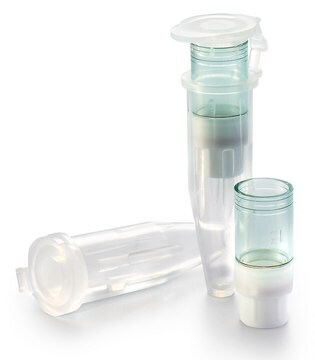MRCF0R030
Microcon® Centrifugal Filters
NMWCO 30 kDa, Ultracel® regenerated cellulose membrane (low binding), sample volume 0.5 mL
Synonym(s):
Centrifuge concentrator
About This Item
Recommended Products
material
Ultracel® regenerated cellulose membrane (low binding)
polyacetal base (membrane support)
polycarbonate device top
polypropylene tube (for filtrate/concentrate)
silicone O-ring (medical-grade)
Quality Level
sterility
non-sterile
feature
holdup volume> 10 μL
manufacturer/tradename
Microcon®
parameter
0.5 mL sample volume
technique(s)
DNA purification: suitable
RNA purification: suitable
protein extraction: suitable
protein purification: suitable
L
4.50 cm (1.8 in.)
diam.
12.3 mm
filtration area
0.32 cm2
pore size
30 kDa NMWCO
shipped in
ambient
Related Categories
General description
•Typical recoveries of greater than 95%, even for dilute solutions
•Reverse spin to maximize recovery, even in the smallest samples
•Convenient storage of filtrate or concentrated sample in standard microfuge tube
•Concentration factors up to 100X
Features:
•High recovery for small volumes with reverse spin (concentration factor less than 20X)
•Low-binding Ultracel membrane
•Fast processing
Sample applications:
•Recovery of genomic DNA for forensic applications
•Concentration and desalting of nucleic acids (high recovery alternative to ethanol precipitation)
•Removal of primers from amplified DNA
•Easy filtrate recovery, exploiting the flat membrane design
Linkage
Legal Information
Storage Class Code
10-13 - German Storage Class 10 to 13
Certificates of Analysis (COA)
Search for Certificates of Analysis (COA) by entering the products Lot/Batch Number. Lot and Batch Numbers can be found on a product’s label following the words ‘Lot’ or ‘Batch’.
Already Own This Product?
Find documentation for the products that you have recently purchased in the Document Library.
Articles
In this study, we developed a rapid trypsin digest kit that, at elevated temperatures, yielded reliable, reproducible results in less than 2 hours on a wide variety of substrates for mass spectrometry.
The use of PNGase Fast denaturing buffer and enzyme yielded results similar to a conventional 20-hour protocol with overnight digest while reducing workflow time to about 1 hour with a 15-minute digest.
Our team of scientists has experience in all areas of research including Life Science, Material Science, Chemical Synthesis, Chromatography, Analytical and many others.
Contact Technical Service


